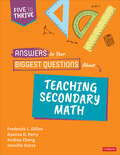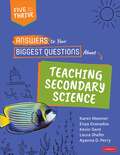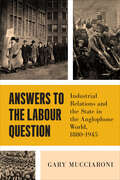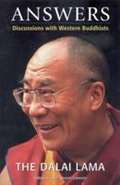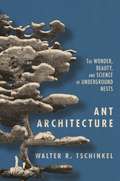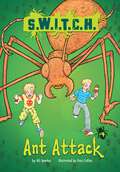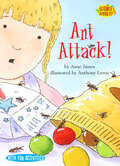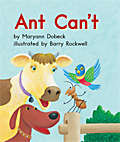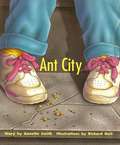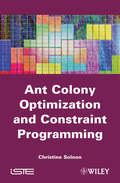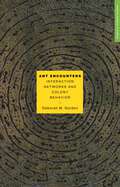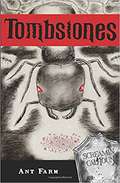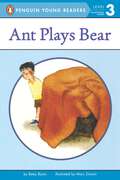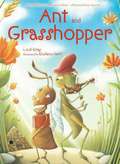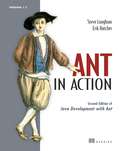- Table View
- List View
Answers to Your Biggest Questions About Teaching Secondary Math: Five to Thrive [series] (Corwin Mathematics Series)
by Frederick L. Dillon Ayanna D. Perry Andrea Negrete Cheng Jennifer OutzsLet’s face it, teaching secondary math can be hard. So much about how we teach math today may look and feel different from how we learned it. Teaching math in a student-centered way changes the role of the teacher from one who traditionally "delivers knowledge" to one who fosters thinking. Most importantly, we must ensure our practice gives each and every student the opportunity to learn, grow, and achieve at high levels, while providing opportunities to develop their agency and authority in the classroom which results in a positive math identity. Whether you are a brand new teacher or a veteran, if you find teaching math to be quite the challenge, this is the guide you want by your side. Designed for just-in-time learning and support, this practical resource gives you brief, actionable answers to your most pressing questions about teaching secondary math. Written by four experienced math educators representing diverse experiences, these authors offer the practical advice they wish they received years ago, from lessons they′ve learned over decades of practice, research, coaching, and through collaborating with teams, teachers and colleagues—especially new teachers—every day. Questions and answers are organized into five areas of effort that will help you most thrive in your secondary math classroom: How do I build a positive math community? How do I structure, organize, and manage my math class? How do I engage my students in math? How do I help my students talk about math? How do I know what my students know and move them forward? Woven throughout, you′ll find helpful sidebar notes on fostering identity and agency; access and equity; teaching in different settings; and invaluable resources for deeper learning. The final question—Where do I go from here?— offers guidance for growing your practice over time. Strive to become the best math educator you can be; your students are counting on it! What will be your first step on the journey?
Answers to Your Biggest Questions About Teaching Secondary Science: Five to Thrive [series]
by Ayanna D. Perry Karen Mesmer Enya Granados Kevin Gant Laura ShaferYour guide to grow and flourish as a science teacher! The past two decades have seen a paradigm shift in science education, thanks in large part to the Next Generation Science Standards (NGSS), which advocate a move away from procedural lab investigations and direct instruction and toward increased emphasis on reasoning, sensemaking, phenomena exploration, problem solving, and collaboration. Under this new paradigm, students are learning real science as scientists practice it, so that more and more students are actively investigating questions and pursuing solutions of their own making. As part of the Five to Thrive series for early-career educators, this comprehensive guide provides those who are new to teaching science, as well as seasoned teachers looking to enhance their practice, the fundamentals to develop best teaching practices that reflect their students’ experiences and requirements. Written by experienced science educators, Answers to Your Biggest Questions About Teaching Secondary Science provides practical guidance on successful strategies and techniques for teaching science in a way that gives every student the opportunity to learn, grow, and achieve at high levels, while providing opportunities to develop their agency and authority in the classroom, ultimately resulting in a positive science identity. The book is organized around five overarching questions and answers that will help you most thrive in your secondary science classroom: How do I build a positive science community? How do I structure, organize, and manage my science class? How do I engage my students in science? How do I help my students talk about science? How do I know what my students know and how can I use that information to plan and move them forward? The book concludes with a sixth question—Where do I go from here?—that provides guidance for growing your practice over time, including discussions on self-care, advocating for students, and an extensive discussion on growing your professional network. Woven throughout, you′ll find helpful sidebar notes on fostering identity and agency; access and equity; teaching in different settings; and invaluable resources for deeper learning.Strive to become the best science educator you can be; your students are counting on it!
Answers to Your Biggest Questions About Teaching Secondary Science: Five to Thrive [series]
by Ayanna D. Perry Karen Mesmer Enya Granados Kevin Gant Laura ShaferYour guide to grow and flourish as a science teacher! The past two decades have seen a paradigm shift in science education, thanks in large part to the Next Generation Science Standards (NGSS), which advocate a move away from procedural lab investigations and direct instruction and toward increased emphasis on reasoning, sensemaking, phenomena exploration, problem solving, and collaboration. Under this new paradigm, students are learning real science as scientists practice it, so that more and more students are actively investigating questions and pursuing solutions of their own making. As part of the Five to Thrive series for early-career educators, this comprehensive guide provides those who are new to teaching science, as well as seasoned teachers looking to enhance their practice, the fundamentals to develop best teaching practices that reflect their students’ experiences and requirements. Written by experienced science educators, Answers to Your Biggest Questions About Teaching Secondary Science provides practical guidance on successful strategies and techniques for teaching science in a way that gives every student the opportunity to learn, grow, and achieve at high levels, while providing opportunities to develop their agency and authority in the classroom, ultimately resulting in a positive science identity. The book is organized around five overarching questions and answers that will help you most thrive in your secondary science classroom: How do I build a positive science community? How do I structure, organize, and manage my science class? How do I engage my students in science? How do I help my students talk about science? How do I know what my students know and how can I use that information to plan and move them forward? The book concludes with a sixth question—Where do I go from here?—that provides guidance for growing your practice over time, including discussions on self-care, advocating for students, and an extensive discussion on growing your professional network. Woven throughout, you′ll find helpful sidebar notes on fostering identity and agency; access and equity; teaching in different settings; and invaluable resources for deeper learning.Strive to become the best science educator you can be; your students are counting on it!
Answers to the Labour Question: Industrial Relations and the State in the Anglophone World, 1880–1945 (Political Development: Comparative Perspectives)
by Gary MucciaroniSince the mid-nineteenth century, public officials, reformers, journalists, and other elites have referred to “the labour question.” The labour question was rooted in the system of wage labour that spread throughout much of Europe and its colonies and produced contending classes as industrialization unfolded. Answers to the Labour Question explores how the liberal state responded to workers’ demands that employers recognize trade unions as their legitimate representatives in their struggle for compensation and control over the workplace. Gary Mucciaroni examines five Anglophone nations – Australia, Canada, Great Britain, New Zealand, and the United States – whose differences are often overlooked in the literature on political economy, which lumps them together as liberal, “market-led” economies. Despite their many shared characteristics and common historical origins, these nations’ responses to the labour question diverged dramatically. Mucciaroni identifies the factors that explain why these nations developed such different industrial relations regimes and how the paths each nation took to the adoption of its regime reflected a different logic of institutional change. Drawing on newspaper accounts, parliamentary debates, and personal memoirs, among other sources, Answers to the Labour Question aims to understand the variety of state responses to industrial unrest and institutional change beyond the domain of industrial relations.
Answers: Discussions With Western Buddhists
by Dalai Lama Xiv Jose Ignacio CabezonIn these lively exchanges the Dalai Lama exhibits clear and penetrating insight into issues that are most important to Western students.
Ant Architecture: The Wonder, Beauty, and Science of Underground Nests
by Walter R. TschinkelAn unprecedented look at the complex and beautiful world of underground ant architectureWalter Tschinkel has spent much of his career investigating the hidden subterranean realm of ant nests. This wonderfully illustrated book takes you inside an unseen world where thousands of ants build intricate homes in the soil beneath our feet.Tschinkel describes the ingenious methods he has devised to study ant nests, showing how he fills a nest with plaster, molten metal, or wax and painstakingly excavates the cast. He guides you through living ant nests chamber by chamber, revealing how nests are created and how colonies function. How does nest architecture vary across species? Do ants have "architectural plans"? How do nests affect our environment? As he delves into these and other questions, Tschinkel provides a one-of-a-kind natural history of the planet's most successful creatures and a compelling firsthand account of a life of scientific discovery.Offering a unique look at how simple methods can lead to pioneering science, Ant Architecture addresses the unsolved mysteries of underground ant nests while charting new directions for tomorrow’s research, and reflects on the role of beauty in nature and the joys of shoestring science.
Ant Attack (S.W.I.T.C.H. #4)
by Ali SparkesDanny and Josh were having a great day until Tarquin, the most annoying boy in the neighborhood, came over to play. He dresses like he's 55, doesn't do anything fun, and pulls the legs off of bugs. The twins thought that their day couldn't get any worse, but when they turn into ants by accident, they realize how wrong they were! Can Danny and Josh find a safe place to hide until they turn human again? And with Tarquin in the garden, will they make it out with all of their legs?
Ant Attack! (Science Solves It!)
by Anne JamesThe Science Solves It! series merges fiction and science in storylines that intrigue kids and encourage them to observe, investigate, predict, and experiment! Young readers ages 5–8 will be inspired by the relatable characters in each story as they solve kid-sized mysteries and dilemmas. Jenny keeps her candy stash a secret until an army of ants discovers where it's hidden. Will she be able to lure them away before the secret is discovered? (Level One; Science topic: Ants)
Ant Can't (Fountas & Pinnell LLI Green #Level C, Lesson 7)
by Maryann DobeckFountas and Pinnell Leveled Literacy Intervention Green System -- 1st Grade
Ant Cities (Let's-Read-and-Find-Out Science #2)
by Arthur DorrosDid you ever wonder where an ant goes when it disappears into an anthill? Underneath the hill, there are miles of tunnels and hundreds of rooms! With simple, easy-to-understand words and colorful illustrations, Arthur Dorros explains the life of a harvester ant for the early reader and even shows readers how to build their own ant farms!
Ant Colony Optimization and Applications (Studies in Computational Intelligence #947)
by Stefka FidanovaThis book is interesting and full of new ideas. It provokes the curiosity of the readers. The book targets both researchers and practitioners. The students and the researchers will acquire knowledge about ant colony optimization and its possible applications as well as practitioners will find new ideas and solutions of their combinatorial optimization and decision-making problems. Ant colony optimization is between the best method for solving difficult optimization problems arising in real life and industry. It has obtained distinguished results on some applications with very restrictive constraints. The reader will find theoretical aspects of ant method as well as applications on a variety of problems. The following applications could be mentioned: multiple knapsack problem, which is an important economical problem; grid scheduling problem; GPS surveying problem; E. coli cultivation modeling; wireless sensor network positioning; image edges detection; workforce planning.
Ant Colony Optimization and Constraint Programming (Wiley-iste Ser.)
by Christine SolnonAnt colony optimization is a metaheuristic which has been successfully applied to a wide range of combinatorial optimization problems. The author describes this metaheuristic and studies its efficiency for solving some hard combinatorial problems, with a specific focus on constraint programming. The text is organized into three parts. The first part introduces constraint programming, which provides high level features to declaratively model problems by means of constraints. It describes the main existing approaches for solving constraint satisfaction problems, including complete tree search approaches and metaheuristics, and shows how they can be integrated within constraint programming languages. The second part describes the ant colony optimization metaheuristic and illustrates its capabilities on different constraint satisfaction problems. The third part shows how the ant colony may be integrated within a constraint programming language, thus combining the expressive power of constraint programming languages, to describe problems in a declarative way, and the solving power of ant colony optimization to efficiently solve these problems.
Ant Encounters: Interaction Networks and Colony Behavior (Primers in Complex Systems #1)
by Deborah M. GordonHow do ant colonies get anything done, when no one is in charge? An ant colony operates without a central control or hierarchy, and no ant directs another. Instead, ants decide what to do based on the rate, rhythm, and pattern of individual encounters and interactions--resulting in a dynamic network that coordinates the functions of the colony. Ant Encounters provides a revealing and accessible look into ant behavior from this complex systems perspective.Focusing on the moment-to-moment behavior of ant colonies, Deborah Gordon investigates the role of interaction networks in regulating colony behavior and relations among ant colonies. She shows how ant behavior within and between colonies arises from local interactions of individuals, and how interaction networks develop as a colony grows older and larger. The more rapidly ants react to their encounters, the more sensitively the entire colony responds to changing conditions. Gordon explores whether such reactive networks help a colony to survive and reproduce, how natural selection shapes colony networks, and how these structures compare to other analogous complex systems.Ant Encounters sheds light on the organizational behavior, ecology, and evolution of these diverse and ubiquitous social insects.
Ant Farm
by Simon RichIn Ant Farm, former Harvard Lampoon president Simon Rich finds humor in some very surprising places. Armed with a sharp eye for the absurd and an overwhelming sense of doom, Rich explores the ridiculousness of our everyday lives. The world, he concludes, is a hopelessly terrifying place-with endless comic potential.-If your girlfriend gives you some "love coupons" and then breaks up with you, are the coupons still valid?-What kind of performance pressure does an endangered male panda feel when his captors bring the last remaining female panda to his cage?-If murderers can get into heaven by accepting Jesus, just how awkward is it when they run into their victims?Join Simon Rich as he explores the extraordinary and hilarious desperation that resides in ordinary life, from cradle to grave."Hilarious." -Jon StewartFrom the Trade Paperback edition.
Ant Farm (Tombstones)
by Screamin CalhounMatt has some new pets: An army of ants that has a never-ending appetite...for just about anything. And if you're not a friend of Matt's, well you'd better be nice. Because in this story these pets are not man's best friend. Welcome to the first TOMBSTONE. Let's hope it's not your last!If you are a fan of Goosebumps, Tombstones will take your taste for terrifying tales to a new level.
Ant Financial
by Feng Zhu Krishna G. Palepu Nancy Hua Dai Ying Zhang Anthony K. WooHeadquartered in Hangzhou (China), Ant Financial has grown into a fintech "Unicorn." The fintech empire that the company established spanned verticals such as mobile and online payment (Alipay), money market fund (Yu'e Bao), wealth management (Ant Fortune), digital-only banking (MYbank), credit scoring (Zhima Credit ), and consumer credit portal (Ant Credit Pay) among others. After another sales record during the 2016 11.11 Global Shopping Festival along with Alibaba, Long Chen, Chief Strategy Officer of Ant Financial was contemplating the various opportunities and challenges associated with the firm's international expansion, inclusive finance in rural regions, and regulatory uncertainties.
Ant Financial (A)
by Feng Zhu Krishna G. Palepu Nancy Hua Dai Ying Zhang Anthony K. WooHeadquartered in Hangzhou (China), Ant Financial has grown into a fintech "Unicorn." The fintech empire that the company established spanned verticals such as mobile and online payment (Alipay), money market fund (Yu'e Bao), wealth management (Ant Fortune), digital-only banking (MYbank), credit scoring (Zhima Credit ), and consumer credit portal (Ant Credit Pay) among others. After another sales record during the 2016 11.11 Global Shopping Festival along with Alibaba, Long Chen, Chief Strategy Officer of Ant Financial was contemplating the various opportunities and challenges associated with the firm's international expansion, inclusive finance in rural regions, and regulatory uncertainties.
Ant Financial (B)
by Feng Zhu Krishna G. Palepu Ying Zhang Anthony K. WooHeadquartered in Hangzhou (China), Ant Financial has grown into a fintech "Unicorn." The fintech empire that the company established spanned verticals such as mobile and online payment (Alipay), money market fund (Yu'e Bao), wealth management (Ant Fortune), digital-only banking (MYbank), credit scoring (Zhima Credit ), and consumer credit portal (Ant Credit Pay) among others. After another sales record during the 2016 11.11 Global Shopping Festival along with Alibaba, Long Chen, Chief Strategy Officer of Ant Financial was contemplating the various opportunities and challenges associated with the firm's international expansion, inclusive finance in rural regions, and regulatory uncertainties.
Ant Group (D)
by Feng Zhu Krishna G. Palepu Kerry Herman Susie L. MaThe (D) case updates the case series from the time of Ant's planned IPO, and the Chinese government's regulatory shifts.
Ant Plays Bear (Penguin Young Readers, Level 3)
by Betsy ByarsIn this delightful follow-up to My Brother, Ant, Anthony comes face to face with a growling bear, pretends to be a dog, and hears a giant tapping on the window. These enchanting stories capture the relationship between Ant and his brother with warmth and humor.
Ant and Elephant
by Sicelo Hlamandana Simangaliso Sibiya Fezile TwalaReader: Level – First Paragraphs
Ant and Grasshopper
by Luli Gray Giuliano FerriWhen Ant spies a carefree Grasshopper playing a fiddle outside on the lawn, Ant immediately harrumphs at the insect's foolishness and continues to go about his very serious business of gathering and counting his food for the winter. But Ant finds Grasshopper's music and whimsy more catchy than he'd like, and soon he's distracted by his own rhyming and doodling! When the harsh winter hits and Ant finds Grasshopper cold and hungry in the snow, he can't help but bring him inside. Only after opening his home to Grasshopper does Ant realize that music, dancing, and laughter have their place in his life, too. Luli Gray's funny twist on this fable will have readers giggling and singing. With Giuliano Ferri's lush and whimsical illustrations, this book is both heartwarming and lovely to behold. Image descriptions present.
Ant in Action: Second Edition of Java Development with Ant
by Erik Hatcher Steve LoughranThis second edition of a Manning bestseller has been revised and re-titled to fit the 'In Action' Series by Steve Loughran, an Ant project committer. Ant in Action introduces Ant and how to use it for test-driven Java application development. Ant itself is moving to v1.7, a major revision, at the end of 2006 so the timing for the book is right. A single application of increasing complexity, followed throughout the book, shows how an application evolves and how to handle the problems of building and testing. Reviewers have praised the book's coverage of large-projects, Ant's advanced features, and the details and depth of the discussion-all unavailable elsewhere.This is a major revision with the second half of the book completely new, including:How to Manage Big projectsLibrary managementEnterprise JavaContinuous integrationDeploymentWriting new Ant tasks and datatypes Purchase of the print book comes with an offer of a free PDF, ePub, and Kindle eBook from Manning. Also available is all code from the book.
